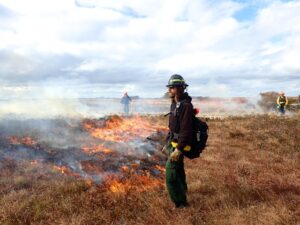Setting fire to nature may seem counterintuitive for a conservation organization. However, fire played a role in natural landscapes long before the idea of prescribed fire came to be. Historically, fire has been an organic process throughout the world, and was intentionally used by Native Americans to clear land for agriculture, hunting, and settlement areas. As a result of both natural and intentional fires, several habitats have co-evolved to tolerate fire and consequently depend on this type of disturbance to thrive.
Prescribed fire has many benefits for early successional ecosystems like the grasslands and heathlands found in Smooth Hummocks and Head of the Plains. It can reduce the biomass of woody shrubs, opening the canopy for grassy and herbaceous species that have seeds waiting to germinate in the seed bank. The resulting mosaic of shrublands and grasslands provides fantastic habitat for songbirds, small mammals, insects, pollinators, and birds of prey such as northern harriers. The remaining ash from a fire acts as a natural fertilizer, helping the plant community to regenerate. Several plant species have specifically been shown to benefit from fire disturbance, including blue eyed grass (Sisyrinchium fuscatum) and lowbush blueberry (Vaccinium angustifolium).
Fire season occurs twice each year, in the spring and fall. Any prescribed burns undertaken by the Land Bank are completed by certified wildland firefighters, with assistance from members of the Massachusetts Department of Conservation & Recreation and the Nantucket Fire Department.


